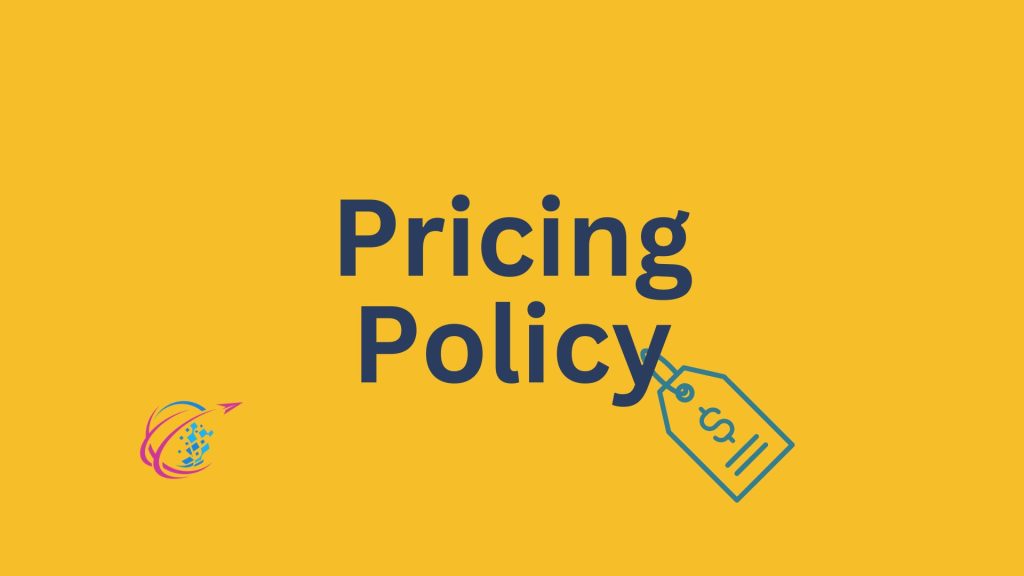Developing a pricing policy is a critical element for any business seeking to balance profitability, market positioning, and customer value. Pricing plays a direct role in determining a company’s revenue and influences how products or services are perceived by the market. The process of developing a pricing policy requires careful analysis, planning, and continuous adjustment to ensure it aligns with business objectives and market trends.
The Importance of Developing a Pricing Policy
A well-structured pricing policy helps businesses establish a consistent approach to setting prices, ensuring fairness for customers while maximizing profits. When developing a pricing policy, businesses must consider factors such as cost structures, customer expectations, competitor pricing, and market conditions. This policy serves as a guide for pricing decisions, providing flexibility while ensuring strategic alignment with financial goals.
The importance of developing a pricing policy cannot be overstated. Without a clear pricing strategy, businesses risk underpricing or overpricing, which can damage profitability or alienate customers. An effective pricing policy balances internal costs with external market forces, ensuring prices remain competitive while maintaining business margins.
A pricing policy also ensures consistency across products, sales channels, and markets. This consistency builds customer trust by showing they are charged fairly based on clear criteria. Additionally, a strong pricing policy enables businesses to respond effectively to market changes, such as shifts in demand or raw material costs, while keeping prices aligned with their overall strategy.
Key Considerations When Developing a Pricing Policy
When developing a pricing policy, businesses must begin by understanding their cost structure. This includes both fixed and variable costs associated with producing and delivering their products or services. By accurately calculating these costs, companies can ensure that prices cover expenses while still generating a healthy profit margin. Failing to account for all costs may lead to pricing strategies that jeopardize the business’s financial sustainability.
Another important factor in developing a pricing policy is understanding the target audience. Customer preferences, purchasing power, and sensitivity to price all play a crucial role in determining the optimal pricing strategy. For example, customers may be willing to pay a premium for products that offer superior quality, convenience, or brand value. In other cases, price-sensitive consumers may be more inclined to seek out lower-cost alternatives. By aligning pricing with customer expectations, businesses can build stronger relationships with their target audience and drive repeat purchases.
In addition to understanding costs and customers, businesses must also evaluate competitor pricing. This involves analyzing the prices set by competitors for similar products or services, as well as their positioning in the market. While it is not always necessary to match or undercut competitor prices, knowing where competitors stand allows businesses to determine whether their prices need to be adjusted to remain competitive. Pricing higher than competitors may be justified by offering additional value, while pricing lower can be an effective way to capture market share.
Dynamic Versus Static Pricing Models
When developing a pricing policy, businesses often choose between dynamic and static pricing models. A static pricing model involves setting fixed prices that remain consistent over time. This approach is straightforward and provides predictability for both the business and customers. Static pricing is commonly used in industries with stable costs and low market fluctuations.
However, in markets with higher volatility, a dynamic pricing model may be more effective. Dynamic pricing allows businesses to adjust prices in real-time based on demand, competition, and other external factors. For instance, businesses in the travel and hospitality industries frequently use dynamic pricing to adjust rates based on factors such as seasonality and booking trends. While dynamic pricing offers greater flexibility, it also requires constant monitoring and adjustment to ensure that prices remain optimal.
Both pricing models have their advantages, and the choice depends on the nature of the business and the market it operates in. Companies must carefully weigh the benefits and challenges of each approach when developing a pricing policy that aligns with their overall goals.
Implementing and Monitoring the Pricing Policy
Once you develop a pricing policy, ensure successful implementation by clearly communicating it across all departments. Marketing, sales, and customer service teams must fully understand the pricing structure to maintain consistent messaging and execution. A well-communicated pricing policy that aligns with the company’s value proposition builds customer trust, fosters loyalty, and strengthens brand reputation.
Regularly monitor your pricing policy to ensure long-term success. Market conditions, customer preferences, and input costs can shift rapidly, requiring quick price adjustments. Continuously evaluating your pricing strategy ensures it meets financial objectives and adapts to external changes.
Tracking key performance indicators (KPIs) such as profit margins, sales volume, and customer feedback helps evaluate how well your pricing policy performs. Use data to adjust pricing strategies and maintain a competitive advantage.
Developing a pricing policy is crucial to a business’s overall strategy. It impacts revenue, customer perceptions, and market positioning. By understanding costs, customers, and competitors, businesses can create a pricing policy that ensures profitability while enhancing customer satisfaction and brand loyalty. Whether using a static or dynamic pricing model, regularly monitoring and adjusting your strategy ensures long-term success in changing market conditions.


